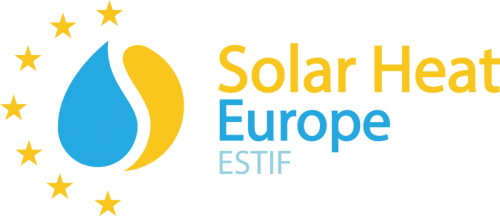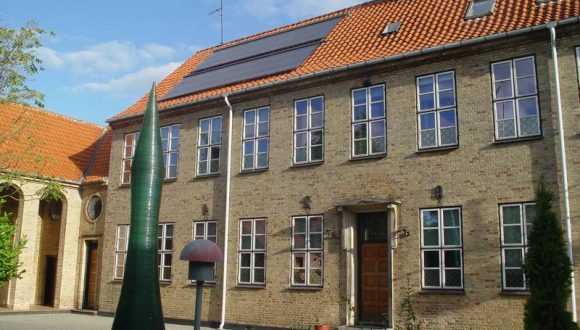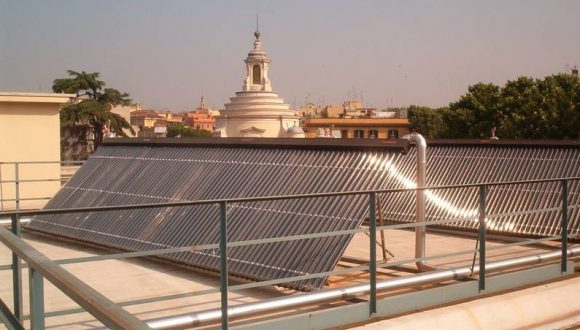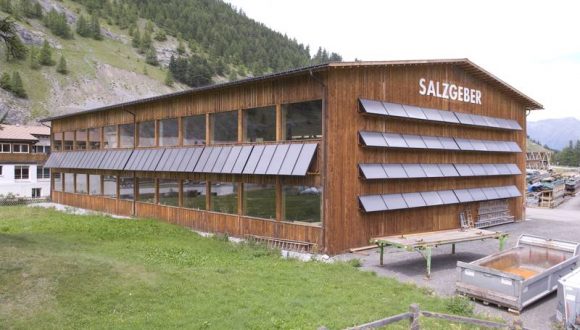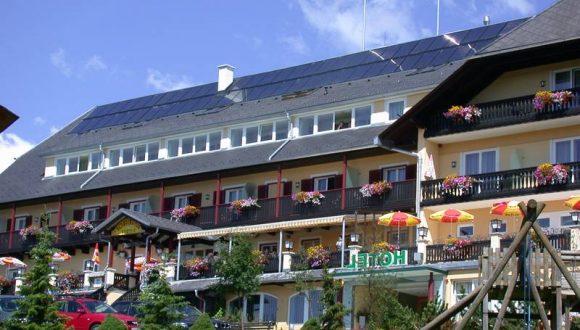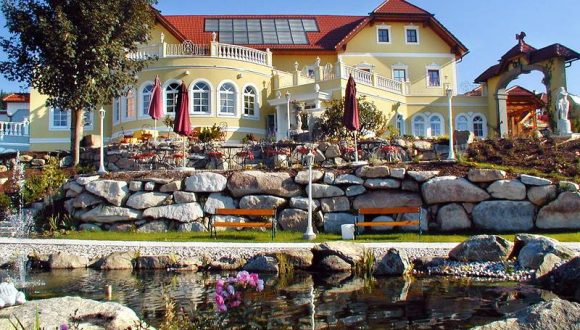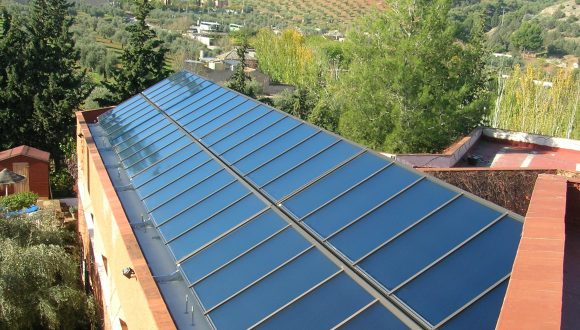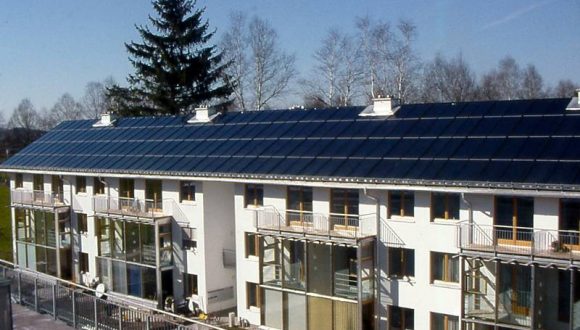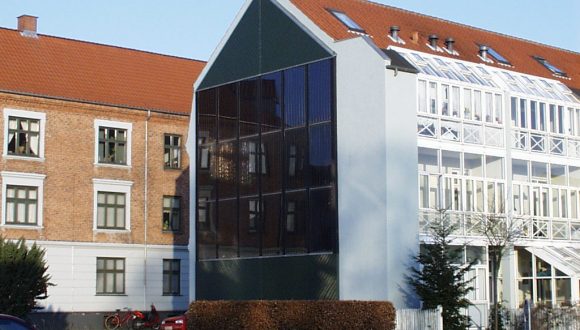Solar Heat for Buildings (residential and commercial)
The use of solar heat in buildings is the most common and wide spread use of solar thermal, not only in Europe but also worldwide. This use can be segmented in terms of system size, ranging from smaller applications for single family houses and medium size for multi-family houses, social amenities or commercial buildings. In terms of applications, it can be subdivided into the supply of domestic hot water, space heating (or combi, when combining both), cooling or low temperature for swimming pools.
Solar thermal collectors for domestic hot water in single family houses is a common application worldwide, and represents the largest share of the solar thermal technology market. At the single family house level, the solar thermal technology is rather mature and has been present in the markets for over 30 years now. Examples of applications can be thus found in each solar thermal market, where the use of collectors for producing domestic hot water in single family houses represents the most common application.
Check out our latest Solar Thermal Market Outlook 2022/2023 to learn more about solar heat applications for buildings, district heating, and industry.
Solar heat for single family houses
- Description of use
- Requirements covered
- Principles and basic operation
- Examples of application
- Benefits
Domestic hot water refers to the heated water used for domestic purposes. Energy consumption for domestic hot water depends on various factors, i.e. consumption patterns: how much hot water is used and the increase in water temperature required (difference between the inlet and outlet temperature). We can consider that, on average, the annual domestic hot water consumption in developed countries is around 1000 kWh per person(1). Domestic hot water demand is rather constant all year round. Solar thermal collectors are therefore particularly suited to meet this demand. In higher latitudes, where the radiation in winter is significantly lower than in summer, such systems can cover between 60 and 80% of the annual domestic hot water demand. This means that a supplementary or backup heater is required. In low latitudes, solar thermal can cover 100% of the domestic hot water demand and no backup heater is required.
Temperature: between 40 to 60 degrees Celsius
This is the usual temperature range required for the most common uses, even if the user lowers the temperature by mixing with cold water.
Control: simple metering and simple control.
These systems require simple metering and control. It is possible to have more advanced
metering and control, and even remote monitoring, but the costs are relatively high when considering the overall investment in such systems. In forced circulation systems usually the control is done using a “solar station”, comprising in one device several components controlling the system.
Operation & Maintenance: generally very low, higher in colder climates.
The operating and maintenance requirements are rather simple, requiring usually one routine visit per year.
The operating principle is rather simple. The sun heats a fluid in a solar collector, which is then used to heat domestic hot water that will be stored in a tank, ready to be used. The system consists of solar thermal collectors, pipes and a hot water store. A thermosiphon system, the simplest, may use only these components. Forced circulation systems are more complex and require, besides the basic components mentioned above, pumps, controller, heat exchanger, valves and backup heater.
The solar thermal collector is the main component of the system. Within the collector, the solar irradiation is captured by an absorber and converted into heat. To increase efficiency, the absorber is often selectively-coated, which means that the absorption of the irradiation is maximised, but the emission of heat is minimized. The absorber heats a fluid circulating in contact with it. This fluid can be just water, a mix of water and glycol (to avoid freezing during the winter in colder climates) or another heat transfer fluid. Solar thermal collectors can heat directly the water that will be used: these are called direct systems. In such systems the water for domestic use circulates inside the solar thermal collector. In contrast to such system, indirect systems use two circulation loops. A first closed-loop system allows the circulation of the heat transfer fluid between the collector and the heat exchanger.
A secondary loop is then used for the circulation of the water for domestic consumption between the heat exchanger and the hot water storage. The figure below shows an example of an indirect system. The heat transfer between the solar fluid and the water is done by means of a heat exchanger. The figure portrays a common thermosiphon system. It takes the name from a physical effect that uses natural convection generated by the expansion of a warm liquid, becoming less dense than colder liquid. The warmer liquid hence moves upwards while the colder liquid moves downwards.
There the thermosiphon systems operate without a pump, using natural convection to carry the hot water to a storage tank located above the solar collector. Because the storage tank is located on the roof, gravity is used to bring the water from the tank to the house. The other configuration is forced circulation systems, as shown on the figure below. In this case, the hot water storage tank is located inside the house. This is a common solution in colder climates, to avoid heat losses in the tank during the winter. In these systems the water is pumped between the collector and the hot water storage tank. Additional backup heating systems, such as gas boilers, usually also feed into the storage tank to cover the eventual shortcomings of the solar thermal system, especially in winter.
Solar thermal collectors for domestic hot water is a common application worldwide, and represents the largest share of the solar thermal technology market. There are two main systems used for this type of application: thermosiphon and forced circulation. Thermosiphon systems are simple and compact, using a thermodynamic principle for operation. As such, thermosiphon are especially effective in warmer climates. Forced circulation systems use a pump to circulate water through the collector and system. This is a solution common in colder climates.
The benefits of solar thermal collectors cover several aspects: environmental, political and economic.
Environmental benefits stem from the capacity to reduce harmful emissions. The reduction of CO2 emissions depends on the quantity of fossil fuels replaced directly or indirectly, i.e. when the system replaces the use of carbon-based electricity used for water heating. Depending on the location, a 2.8 kWth (4 m²) system could generate the equivalent of 2.2 MWhth /year, a saving of around 350 Kg of CO2.
Political and economic benefits are associated with the potential savings in energy costs and the possibility of improving energy security by reducing energy imports, while creating local jobs related to the manufacturing, commercialization, installation and maintenance of solar thermal systems.
Regarding energy costs and potential savings, there are three main aspects to consider that have a bigger impact on the comparable costs of the energy produced by a solar thermal system. These are the initial cost of the system, the lifetime of the system and the system performance. These factors depend on the location (affecting climate, insulation, taxes, cost of living, etc.) and quality of the system (affecting performance, lifetime and cost). This can vary significantly from country to country. Therefore, average investment costs for solar thermal systems can vary greatly from country to country and between different systems. In China, direct thermosiphon systems for single family houses with average 4 m² (2.8 kWth) collector size can cost from 90 to 225 EUR/kWth and have an energy cost ranging from 1.8 to 4.5 EUR cents/kWhth. In the Mediterranean region, the average cost for a open-loop, pressure-less thermosiphon systems (180 lts hot water, 70 lts feeding tank) is around 830 EUR. Pumped indirect systems investment costs can go from 765 and 1710 EUR/kWth in central Europe, while in northern Europe they can go up to between 1440 to 2160 EUR/kWth. In terms of energy costs, the former can range from 9.5 to 13.5 EUR cents/kWhth while the latter may range between 16.7 to 26.55 EUR cents/kWhth. The most competitive systems in Europe are the thermosiphon systems in Southern Europe, with costs as low as 4 to 6 EUR cents/kWhth.
Solar heat for multi-family houses
- Description of use
- Examples of applications
- Requirements covered
- Principles and basic operation
- Benefits
Domestic hot water refers to the heated water used for domestic purposes. Energy consumption for domestic hot water depends on different factors, namely consumption patterns: how much hot water is used and the increase in water temperature required (difference between the inlet and the outlet temperature). We can consider that, on average, the annual energy consumption for preparing domestic hot water in developed countries is around 1 000 kWh per person.
Domestic hot water demand is rather constant all year round. Solar thermal collectors are, therefore, particularly suited to meet this demand. In higher latitudes, where the radiation in winter is significantly lower than in summer, such systems can cover between 60 and 80% of the annual domestic hot water demand. This means that a supplementary or backup heater is required. In low latitudes, solar thermal can cover 100% of the domestic hot water demand and no backup heater is required.
These applications mainly use forced circulation systems, but in warmer climates it is also possible to use thermosiphon systems in multi-family houses, in particular using individual systems serving each dwelling. Forced circulation systems use a pump to circulate water through the collector and system. Sensors and a controller activate the pump. In these systems, the hot water store is located inside the building. The configuration of these systems may vary, as it is possible to have central or individual backup heaters and common or separate hot water stores. The solar thermal collectors’ area in systems providing domestic hot water in multi-family houses vary greatly in terms of size, depending on requirements. It is usually between 10 and 50m² (7 to 35 kWth), although much larger installations exist.
Temperature: between 40 to 60 degrees Celsius
This is the usual temperature range required for the most common uses, such as showering, even if the user lowers the temperature by mixing with cold water
Control: simple metering and simple control.
These systems require simple metering and control. Although it is possible and even desirable, for larger and/or commercial systems, to have advanced metering and control, with remote monitoring
Operation & Maintenance: generally very low, higher in colder climates.
The operating and maintenance requirements are rather simple, requiring usually one routine visit per year.
The operating principle is rather simple. The sun heats a fluid in a solar collector, which is then used to heat domestic hot water that will be stored in a tank, ready to be used. Larger systems are usually forced circulation systems, consisting of solar thermal collectors, pipes, hot water store, pumps, controller, heat exchanger, valves and backup heater. The collector captures solar irradiation using a selectively-coated metal sheet (absorber). The heat is absorbed by a fluid circulating in contact with the absorber. The heat from this fluid is then transferred to domestic hot water by a heat exchanger. The domestic hot water is stored in a tank, ready for use. Additional water heating systems, such as gas boilers, usually also feed into the storage tank.
The benefits of solar thermal collectors cover several aspects: environmental, political and economic.
Environmental benefits stem from the capacity to reduce harmful emissions. The reduction of CO2 emissions depends on the quantity of fossil fuels replaced directly or indirectly, for instance, when the system replaces the use of carbon-based electricity used for water heating. Depending on the location, a system of 14 kWth (20 m²), could generate the equivalent of 11 MWhth /year, a saving of around 1.75 Mt CO2 (2).
Political and economic benefits are associated with the potential savings in energy costs and the possibility of improving energy security by reducing energy imports, while creating local jobs related to the manufacturing, commercialization, installation and maintenance of solar thermal systems.
Regarding energy costs and potential savings, there are three main aspects to consider that have a bigger impact on the comparable costs of the energy produced by a solar thermal system. These are the initial cost of the system, the lifetime of the system and the system performance. These factors depend on the location (affecting climate, insulation, taxes, cost of living, etc.) and quality of the system (affecting performance, lifetime and cost). This can vary significantly from country to country. Therefore, average investment costs for solar thermal systems can vary greatly from country to country and between different systems. Thermosiphon systems, the cheapest, are more appropriate for single family houses (or individual supply). For multi-family houses pumped indirect systems are appropriate. For these, investment costs can go from 765 to 1710 EUR/kWth in central Europe, while in northern Europe they can go up to between 1440 to 2160 EUR/kWth. In terms of energy costs, the former can range from 16.7 to 26.6 EUR cents/kWhth while the latter may range between 9.5 to 23.9 EUR cents/kWhth.
Solar heat for the production of hot water in non-residential buildings
- Description of use
- Examples of applications
- Requirements covered
- Principles and basic operation
- Benefits
Domestic hot water refers to the heated water used for domestic purposes. Energy consumption for domestic hot water depends on different factors, namely consumption patterns, how much hot water is used and the increase in water temperature required (difference between the inlet and the outlet temperature). We can consider that, on average, the annual energy consumption for domestic hot water in developed countries is around 1000 kWh per person (1).
Domestic hot water demand is rather constant all year round. Solar thermal collectors are, therefore, particularly suited to meet this demand. In higher latitudes, where the radiation in winter is significantly lower than in summer, such systems can cover between 60 and 80% of the annual domestic hot water demand. This means that a supplementary or back-up heater is required. In low latitudes, solar thermal can cover 100% of the domestic hot water demand and no backup heater is required.
These applications use mainly forced circulation. They are used in different social amenities, wherever there is a substantial use of domestic hot water. These can include schools, hospitals, swimming pools and sport facilities, dormitories, retirement homes, etc. These applications are similar to some in commercial buildings, such as hotels, camp sites, shopping centres, restaurants, car washes, etc. Such installations vary widely in terms of size, depending on requirements. The main factors to be considered regarding the demand profile are: the hot water demand in terms of quantity, i.e. when it is needed, the amount and desired temperature (to assess the energy required to warm it up from the inlet to the outlet temperature). This size of these systems can vary hugely, from relatively small systems of 10 m² (7 kWth) to systems of 500m² (350 kWth), or even larger.
Temperature: between 40 to 60 degrees Celsius
This is the usual temperature range required for the most common uses, even if the user lowers the temperature by mixing with cold water.
Control: Simple control and simple metering. Advanced control & monitoring possible and recommended.
These systems require simple metering and control. Although it is possible, and even desirable, for larger and/or commercial systems to have advanced metering and control, with remote monitoring.
Operation & Maintenance: generally very low, higher in colder climates.
The operating and maintenance requirements are rather simple, requiring usually one routine visit per year.
The operating principle is rather simple. The sun heats a fluid in a solar collector, which is then used to store domestic hot water in a hot water store, ready to be used. Larger systems are usually forced circulation systems, consisting of solar thermal collectors, pipes, hot water store, pumps, controller, heat exchanger, valves and backup heater. The solar irradiation is captured by an absorber and converted into heat. To increase efficiency, the absorber is often selectively-coated, which means that the absorption of the irradiation is maximised, but the emission of heat is minimized. The absorber heats a fluid circulating in contact with it. The heat carried in this fluid is then transferred to domestic hot water by a heat exchanger. The domestic hot water is pumped into a hot water storage tank, ready for use. Additional water heating systems, such as gas boilers, usually also feed into the hot water store.
The benefits of solar thermal collectors cover several aspects: environmental, political and economic.
Environmental benefits are associated with the capacity to reduce harmful emissions. The reduction in CO2 emissions depends on the quantity of fossil fuels replaced directly or indirectly, for instance, when the system replaces the use of carbon-based electricity used for water heating. Depending on the location, a system of 14 kWth (20 m²) could generate the equivalent of 11 MWhth /year, a saving of around 1.75 Mt CO2 (2).
Political and economic benefits relate to the potential savings in energy costs and to the possibility of improving energy security by reducing energy imports, while creating local jobs related to the manufacturing, commercialization, installation and maintenance of solar thermal systems.
Regarding energy costs, and potential savings, there are three main aspects to consider that have a bigger impact on the comparable costs of the energy produced by a solar thermal system. These are the initial cost of the system, the lifetime of the system and the system performance. These factors depend on the location (affecting climate, insulation, taxes, cost of living, etc.) and quality of the system (affecting performance, lifetime and cost). This can vary significantly from country to country. Therefore, average investment costs for solar thermal systems can vary greatly from country to country and between different systems. Thermosiphon systems, the cheapest, are more appropriate for single family houses (or individual supply). For social amenities, pumped indirect systems are the most commonly used. For these, investment costs can go from 765 to 1710 EUR/kWth in central Europe, while in northern Europe they can go up to between 1440 to 2160 EUR/ kWth. In terms of energy costs, the former can range from 16.7 to 26.6 EUR cents/kWhth while the latter may range between 9.5 to 23.9 EUR cents/kWhth.
